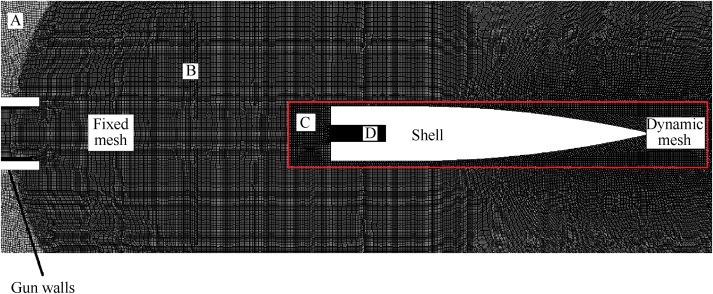El artículo de la referencia investiga las primeras fases de la balística reactiva para proyectiles de gran calibre disparados desde un arma, utilizando una combinación de métodos de dinámica de fluidos computacional (CFD) axisimétricos 0D y 2D. Detalla el desarrollo de un código de parámetros agrupados (LPC) de balística interior (IB) que incorpora un nuevo enfoque de procesamiento de imágenes para calcular la regresión de los granos de propulsante. El código CFD CEDRE de ONERA, mejorado con la técnica de malla dinámica (DMT), está integrado con el LPC para simular la IB con precisión. Las pruebas de validación se alinean bien con la literatura existente. Además, CEDRE se utiliza para modelar la balística intermedia, incluido el vuelo libre del proyectil, con métodos reactivos y multiespecies. En un enfoque, un problema inverso resuelve las configuraciones óptimas del propulsante del arma para cumplir con los requisitos específicos de velocidad inicial y presión. La metodología también explora la dinámica de la llama y la despresurización en un canal de Base Bleed (culote hueco) (BB) en la boca del cañón, con variaciones de presión que coinciden con los estudios establecidos.
Abstract
The aim of this paper is to simulate and study the early moments of the reactive ballistics of a large caliber projectile fired from a gun, combining 0D and 2D axisymmetric Computational Fluid Dynamics (CFD) approaches. First, the methodology is introduced with the development of an interior ballistics (IB) lumped parameter code (LPC), integrating an original image processing method for calculating the specific regression of propellant grains that compose the gun propellant. The ONERA CFD code CEDRE, equipped with a Dynamic Mesh Technique (DMT), is then used in conjunction with the developed LPC to build a dedicated methodology to calculate IB. First results obtained on the AGARD gun and 40 mm gun test cases are in a good agreement with the existing literature. CEDRE is also used to calculate intermediate ballistics (first milliseconds of free flight of the projectile) with a multispecies and reactive approach either starting from the gun muzzle plane or directly following IB. In the latter case, an inverse problem involving a Latin hypercube sampling method is used to find a gun propellant configuration that allows the projectile to reach a given exit velocity and base pressure when IB ends. The methodology developed in this work makes it possible to study the flame front of the intermediate flash and depressurization that occurs in a base bleed (BB) channel at the gun muzzle. Average pressure variations in the BB channel during depressurization are in good agreement with literature.
![]() Fuente: https://www.sciencedirect.com
Fuente: https://www.sciencedirect.com


